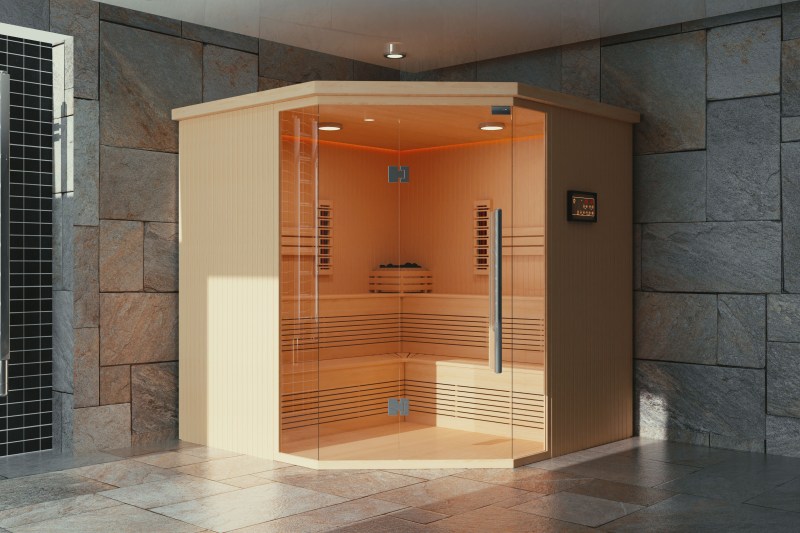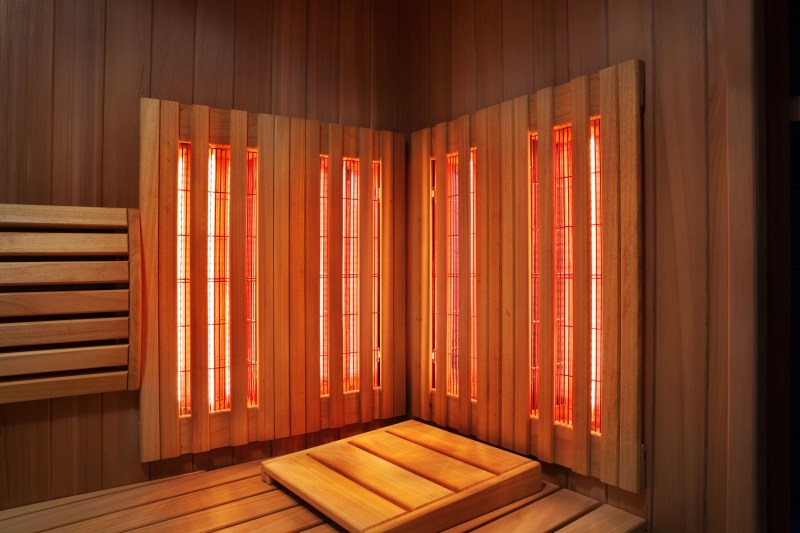
You’ve considered all the options, from a traditional wood-burning sauna to an electric one, and realized the one for you is an infrared sauna. Great choice. Infrared saunas offer a bunch of health benefits, and they are perfect for people who want to sweat a lot but not roast in extreme temperatures. The next step in the process is choosing your at-home sauna kit. But before you do that, there are a few things that you should consider to ensure the home sauna you choose will suit your space.

Here’s how to choose the best sauna for your health goals
When choosing an infrared sauna kit, here are a few things that you should look out for to ensure a safe and enjoyable investment for years to come.
Measure your space
Before purchasing an infrared sauna kit, the first step is to measure the available space in your home where you plan to install the sauna. Consider the dimensions of the kit and ensure that it fits comfortably in the designated area. If needed, consider portability as a variable in your decision. Measure the width, height, and depth of the space to compare it with the dimensions of the sauna kit you’re interested in. Additionally, make sure to leave some clearance around the sauna for ventilation and easy access.
Calculate your budget
Setting a budget is crucial when selecting an infrared sauna kit. Prices can vary significantly depending on the size, features, materials, and brand. Determine how much you’re willing to invest in a home sauna and explore options within your budget range. While it’s tempting to go for the cheapest option available, keep in mind that higher-quality saunas often come with better features, longer warranties, and improved performance, making them a worthwhile long-term investment. Also, be prepared for additional hidden costs.
Choose low-EMF levels
Electromagnetic fields (EMFs) are a concern with electrical devices, including infrared saunas. While infrared saunas haven’t been studied that well yet, high-EMF levels are considered bad for health due to potential adverse effects. To ensure a safe and healthy personal sauna experience, prioritize saunas with low-EMF levels. Some at-home infrared saunas don’t explicitly say whether they are high- or low-EMF. If that’s the case, don’t risk purchasing it because it’s likely a high-EMF model.
Research different brands and models to find one that offers reduced EMF emissions without compromising on performance. Manufacturers may provide EMF testing reports, which can be helpful in making an informed decision.
Choose your infrared heater
The type of infrared heater used in the sauna greatly impacts the overall experience. There are three main types: carbon, ceramic, and full-spectrum heaters.
- Carbon heaters are popular for their even heat distribution. They consist of large, flat panels with a carbon fiber element, which emits long-wave FAR-infrared radiation. This type of infrared heat is gentle and comfortable and it penetrates deep into the body, providing a soothing and relaxing experience.
- Ceramic heaters are popular for their affordability and temperature. They have ceramic rods or plates that emit MID-infrared radiation. While they do take longer to heat up and may not distribute heat as evenly as carbon heaters, they are still effective at generating a comfortable and relaxing sauna experience.
- Full-spectrum heaters are ideal for their ability to emit NEAR-, MID-, and FAR-infrared wavelengths. To achieve this, full-spectrum heaters typically have carbon and ceramic elements.
Choose a kit with high-quality materials
Trust me, if you skimp on the materials, you will feel it when you start to use your personal sauna at home. High-quality materials are crucial aspects of the durability, performance, and overall safety of your home sauna. Here are some essential factors to consider when selecting a sauna building kit with top-notch materials:
- Premium wood: Wood is the primary material used in sauna construction, so choose the right type. Look for sauna kits made from premium-quality wood that’s been treated in a kiln the Scandinavian way. Cedar is a popular choice due to its pleasant aroma and natural resistance to moisture, decay, and insects. Alternatively, hemlock and fir are also good choices. Avoid sauna kits made from pine and spruce because they are prone to warping, and don’t try hardwoods like oak because they have a high thermal conductivity. Lower-grade woods may not withstand the heat and humidity of regular sauna use, which will affect the longevity of your sauna.
- Nontoxic finishes and adhesives: Ensure that the sauna building kit uses nontoxic finishes and adhesives. Saunas operate at high temperatures, causing materials to release volatile organic compounds (VOCs) if they contain harmful chemicals. Choose kits with water-based finishes or natural oils that are safe for both you and the environment. Nontoxic adhesives contribute to the sauna’s structural integrity while preventing any health hazards due to off-gassing.
- Stainless steel hardware: The hardware used in the sauna kit should be made of stainless steel. Stainless steel is resistant to rust and corrosion, ensuring the structural integrity of the sauna. Inferior hardware made of materials like regular steel or iron may deteriorate over time due to exposure to moisture and heat, leading to potential safety risks.
- Tempered glass doors: If the sauna kit includes a glass door, ensure the dooris tempered glass. Tempered glass is specifically designed to withstand high temperatures, making it safe and durable for sauna use. Additionally, tempered glass is less likely to shatter if accidentally impacted, reducing the risk of injury.
- Precise manufacturing: Choose a sauna building kit from a reputable manufacturer known for precision in craftsmanship. A well-made kit will have components that fit together seamlessly, ensuring a sturdy and secure sauna structure. Look for customer reviews and testimonials to gauge the manufacturer’s reputation for producing high-quality sauna kits.
- Warranty and customer support: A reliable warranty is a testament to the manufacturer’s confidence in the quality of its product. Check the terms and conditions of the warranty provided with the sauna building kit. Additionally, consider the availability and responsiveness of customer support in case you encounter any issues or need assistance during the assembly process.
Choose a kit with easy assembly
Unless you’re a seasoned DIY enthusiast, opting for a sauna kit with straightforward assembly is a wise decision. Check the product reviews and descriptions to gauge the ease of assembly. Some at-home sauna kits come with pre-cut parts and detailed instructions, which makes the process more manageable, even for beginners. Some models only require a power tool to screw the pieces together. Others require drills, mallets, wrenches, or even a saw.

Final thoughts on choosing an at-home infrared sauna kit
Selecting the perfect infrared sauna kit for your home involves careful consideration of these actors. By following these guidelines, you can confidently choose an infrared sauna kit that suits your space and health goals, guaranteeing a relaxing, rejuvenating, and long-lasting sauna experience for you and yours in the comfort of your own home.



